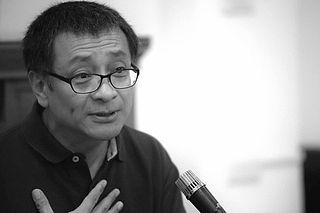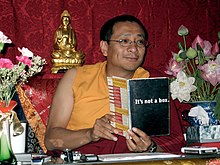
Chögyam Trungpa was a Tibetan Buddhist meditation master and holder of both the Kagyu and Nyingma lineages of Tibetan Buddhism, the 11th of the Trungpa tülkus, a tertön, supreme abbot of the Surmang monasteries, scholar, teacher, poet, artist, and originator of a radical re-presentation of Tibetan Buddhist teachings and the myth of Shambhala as an enlightened society that was later called Shambhala Buddhism.
Reginald Ray is an American Buddhist academic and teacher.
In Mahayana Buddhism, bodhicitta,, is the mind (citta) that is aimed at awakening (bodhi), with wisdom and compassion for the benefit of all sentient beings. Bodhicitta is the defining quality of the Mahayana bodhisattva and the act of giving rise to bodhicitta (bodhicittotpāda) is what makes a bodhisattva a bodhisattva. The Daśabhūmika Sūtra explains that the arising of bodhicitta is the first step in the bodhisattva's career.

Thrangu Rinpoche was born in 1933 in Kham, Tibet. He is deemed to be a prominent tulku in the Kagyu school of Tibetan Buddhism, the ninth reincarnation in his particular line. His full name and title is the Very Venerable Ninth Khenchen Thrangu Tulku, Karma Lodrö Lungrik Maway Senge. The academic title Khenchen denotes great scholarly accomplishment, and the term Rinpoche is a Tibetan devotional title which may be accorded to respected teachers and exemplars.

Nyingma is the oldest of the four major schools of Tibetan Buddhism. It is also often referred to as Ngangyur, "order of the ancient translations". The Nyingma school is founded on the first lineages and translations of Buddhist scriptures from Sanskrit into Tibetan in the eighth century, during the reign of King Trisong Detsen.
In Tibetan Buddhism, Ngöndro refers to the preliminary, preparatory or foundational practices or disciplines common to all four schools of Tibetan Buddhism and also to Bon. They precede deity yoga.

The 7th Dzogchen Ponlop is an abbot of Dzogchen Monastery, founder and spiritual director of Nalandabodhi, founder of Nītārtha Institute for Higher Buddhist Studies, a leading Tibetan Buddhist scholar, and a meditation master. He is one of the highest tülkus in the Nyingma lineage and an accomplished Karma Kagyu lineage holder.
The term Shambhala Buddhism was introduced by Sakyong Mipham in the year 2000 to describe his presentation of the Shambhala teachings originally conceived by Chögyam Trungpa as practices for achieving an enlightened society, in concert with the Kagyu and Nyingma schools of Tibetan Buddhism. The Shambhala Buddhist sangha considers Sakyong Mipham to be its head, and the second in a lineage of Sakyongs ; with his father, Chögyam Trungpa, being the first.
The pointing-out instruction is an introduction to the nature of mind in the Tibetan Buddhist lineages of Mahāmudrā and Dzogchen. In these traditions, a lama gives the pointing-out instruction in such a way that the disciple successfully recognizes the nature of mind.

Diamond Way Buddhism is a lay organization within the Karma Kagyu school of Tibetan Buddhism. The first Diamond Way Buddhist center was founded in 1972 by Hannah Nydahl and Ole Nydahl in Copenhagen under the guidance of Rangjung Rigpe Dorje, 16th Karmapa. Today there are approximately 650 centers worldwide, directed by Ole Nydahl under the guidance of Trinley Thaye Dorje, one of two claimants to the title of the 17th Karmapa. Buddhist teachers such as Sherab Gyaltsen Rinpoche and Lama Jigme Rinpoche visit Diamond Way Buddhist centers and large meditation courses.
Dennis Hunter is an American writer.
Nītārtha Institute is a school of advanced Buddhist studies for Western students designed based upon the traditional Tibetan monastic university curriculum. Its teachers include the published translator Karl Brunnholzl, as well as the head of Nalandabodhi, The Dzogchen Ponlop Rinpoche.

The Sheja Dzö or "Treasury of Knowledge" is a voluminous work by Jamgon Kongtrul (1813–1899). It is constituted by a root text in verse "The Encompassment of All Knowledge" and an autocommentary in prose, 'The Infinite Ocean of Knowledge'. The Treasury of Knowledge is widely considered Jamgon Kongtrul's masterpiece, covering the full spectrum of Buddhist history according to the knowledge then current in the Himalayas; the Abhidharma through the lens of Vasubandhu ; the Buddhist philosophy preserved, categorized and developed in the Himalayas; and the many streams of Buddhist sādhanā both exoteric (sutrayana) and esoteric (vajrayana), transmitted to, maintained and developed by the many trans-Himalayan lineages, such as Mahamudra and Dzogchen. The breadth of the Sheja Dzö is encyclopedic and its approach ecumenical. The root text in verse is terse and ostensibly glib approaching telegraphic. Whereas, the tone and register of the commentary is non-sectarian in regards to the many systems of Buddhadharma it enshrines. The Sheja Dzö is the central reference and general auspice work in Rimé movement literature.
Samatha (Pāli) or śamatha is a Buddhist term that is often translated as the "tranquility of the mind", or "mind-calmness". The Pali Canon describes it as one of two qualities of mind which is developed (bhāvanā) in Buddhist meditation, the other being vipassana (insight). Originally, samatha was developed by abiding in the jhanas, but the later Buddhist tradition also re-introduced single-pointed meditation, which includes a variety of mind-calming techniques, as a means to develop calm. Samatha is common to many Buddhist traditions.
Yuthok Nyingthig is a tantric cycle composed by Yuthok Yontan Gonpo the Younger. It is a system of Buddhist practice which combines Traditional Tibetan medicine and Vajrayāna practices. These are the primary Vajrayāna practices of Tibetan medicine practitioners.
Rigpa is the name of an international Buddhist organization founded by Sogyal Rinpoche in 1979. It has centers and groups in 41 countries around the world. Following allegations of sexual and physical abuse in a letter by former students in 2017, Rigpa commissioned an independent investigation which found those claims to be largely substantiated, along with evidence of a cover-up. According to its website, Rigpa seeks to make the teachings of Buddha available to benefit as many people as possible, and to offer those following the Buddhist teachings a complete path of study and practice, along with the environment they need to explore the teachings to their fullest.

Kagyu Samye Dzong London Tibetan Buddhist Centre for World Peace and Health is the London branch of Kagyu Samye Ling Monastery in Scotland. Kagyu Samye Dzong London is under the direct guidance of Chöje Akong Tulku Rinpoche and Venerable Lama Yeshe Losal Rinpoche, the co-founder and Abbot of Samye Ling respectively.
Karma in Tibetan Buddhism is one of the central issues addressed in Eastern philosophy, and an important part of its general practice.
The Bhāvanākrama is a set of three Buddhist texts written in Sanskrit by the Indian Buddhist scholar yogi Kamalashila of Nalanda university. These works are the principal texts for mental development and the practice of shamatha and vipashyana in Tibetan Buddhism and have been "enormously influential". The texts survive in full Tibetan translation, part 1 and 3 also survive in Sanskrit. The Bhāvanākramas are also one of the favorite texts of the 14th Dalai Lama, who has translated and written a commentary on the middle Bhk.

Trungram Gyalwa Rinpoche is the head of the Trungram lineage and one of the highest tulkus of the Kagyu lineage of Tibetan Buddhism. He has received extensive transmissions of the Nyingma lineages, and teaches in the spirit of the nonsectarian Rimé movement. He is also the first incarnate lama to earn a Ph.D. in the West, having completed a doctoral program in Indo-Tibetan Buddhist Studies at Harvard University. Widely recognized for his ability to modernize ancient Buddhist teachings for today's challenges, he is dedicated to the value of education in bringing wisdom to life. To realize this vision, he has founded organizations throughout Asia and the United States.









